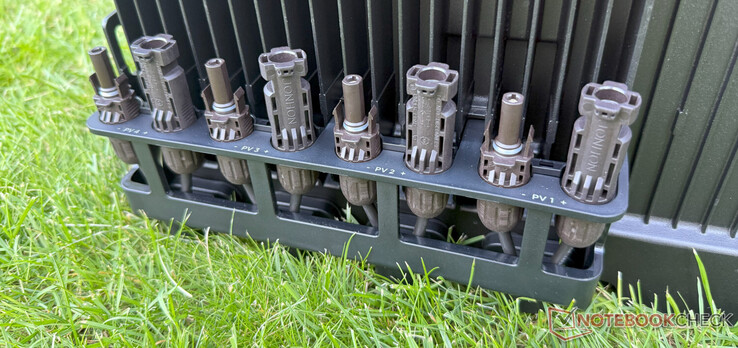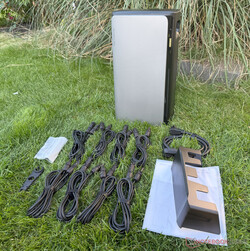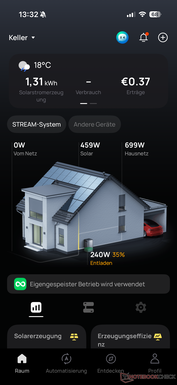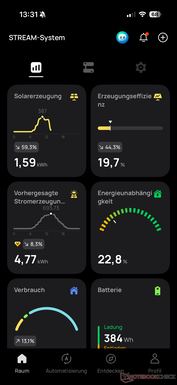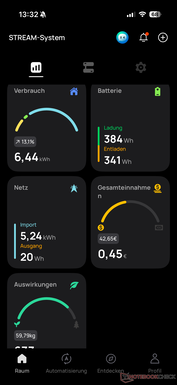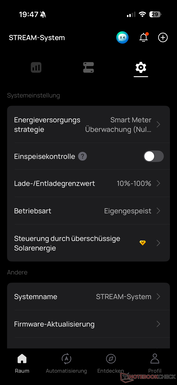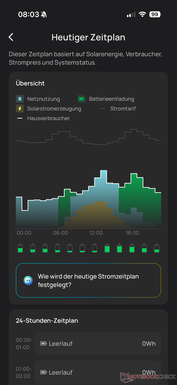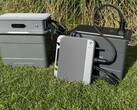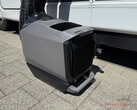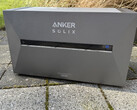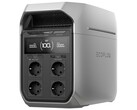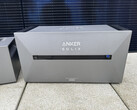
Decentralized balcony power plant system avoids 800 W limit: EcoFlow Stream in a practical test
Over 800 W possible.
With Stream, EcoFlow offers a powerful balcony power plant system that not only enables decentralized storage, but also legally bypasses the European limit of 800 W. Our EcoFlow Stream test reveals how this works and what the system can do.Marcus Schwarten 👁 (translated by DeepL / Marcus Schwarten) Published 🇩🇪 🇫🇷 ...
EcoFlow Stream test summary: Decentralized and versatile
With Stream, EcoFlow offers a complex and versatile configurable balcony power plant system that offers more options than other solutions thanks to its decentralized approach. To a certain extent, the 800 W limit for the supply of household appliances can be circumvented, although you are still subject to legal restrictions in Europe.
A practical feature is the now common option of linking to a dynamic electricity tariff, which further increases the savings potential in addition to harvesting your own electricity from up to 2,000 Wp solar panels. However, the efficiency losses should definitely be kept in mind here, but this also applies to other manufacturers. The fact that EcoFlow sells some of the features as a subscription is annoying, but understandable from the manufacturer's point of view.
Overall, EcoFlow Stream is an exciting alternative for anyone who not only wants to have a balcony power station system in the garden or on the balcony, but can also live with batteries in the house. Appliances anywhere in the home can then be supplied with up to 2,300 W via self-generated solar energy. No other system can do this.
Pros
Cons
Price and availability
EcoFlow Stream is not available in the US. In Europe the EcoFlow Stream series starts at 599 euros (MSRP) for the Stream AC. The prices increase up to 1,499 euros for the top model Stream Ultra X, whereby the manufacturer often offers different deals - as is currently the case.
The products are available directly from the manufacturer and from Amazon, among others, and also as bundles with solar panels and other accessories on request.
EcoFlow has launched Stream this springg. It's a comprehensive and decentralized system that not only supplements balcony power plants with storage in almost any quantity, but also bypasses the 800 W limit to a certain extent. In a detailed practical test, we took a look at exactly how this works, what EcoFlow Stream offers and for whom it is the right solution.
Specifications: EcoFlow Stream at a glance
Before we go into the function and our evaluation of EcoFlow Stream, let's start with an overview of the system. This is because it comprises a whole range of products with different functions and tasks. Only few weeks ago ecoFlow Stream was expanded to include the new top-of-the-range Stream Ultra X model, which we also included in our EcoFlow Stream review.
| Stream model | Ultra X | Ultra | Pro | Max | AC Pro | AC |
|---|---|---|---|---|---|---|
| Capacity | 3.84 Wh | 1.92 kWh | 1.92 kWh | 1.92 kWh | 1.92 kWh | 1.92 kWh |
| Number of MPPT | 4 | 4 | 3 | 2 | 0 | 0 |
| PV input power | 2,000 W | 2,000 W | 1,500 W | 1,000 W | - | - |
| AC output (grid-connected) | 800 W | 800 W | 800 W | 800 W | 1,200 W | 800 W |
| AC charging input | 1,200 W | 1,050 W | 1,050 W | 1,050 W | 1,050 W | 800 W |
| AC output | 1,200 W | 1,200 W | 1,200 W | 1,200 W | 1,200 W | 800 W |
| Bypass output | 2,300 W | 2,300 W | 2,300 W | 2,300 W | 2,300 W | - |
| Dimensions | 420 × 294 × 460 mm | 283 x 255 x 458 mm | 283 x 255 x 458 mm | 283 x 255 x 458 mm | 254 x 255 x 458 mm | 254 x 255 x 458 mm |
| Weight | 38.8 kg | 23.1 kg | 22.8 kg | 22.0 kg | 21.5 kg | 21.2 kg |
| MSRP | 1,499 Euro | 1,099 Euro | 999 Euro | 899 Euro | 799 Euro | 699 Euro |
Features: How EcoFlow Stream works
As the table above shows, EcoFlow Stream currently comprises six different storage models. Four of them (Stream Ultra X, Stream Ultra, Stream Pro and Stream Max) are equipped with two to four MPPTs, depending on the version, so that several solar panels with 1,000 to 2,000 Wp of solar power can be connected directly to them. The energy generated from the sunlight is then stored in the 1.92 to 3.84 kWh battery and fed into the house with up to 800 W, depending on the settings and requirements.
However, the system goes one step further by circumventing the legal requirements of a maximum 800 W power supply. Most models (apart from Stream AC) have two dedicated sockets that can supply up to 2,300 W. This means that appliances with a consumption of more than 800 W can also be supplied directly with solar power. However, this requires the appliances to be connected directly to the storage system, which is usually only possible for a few consumers, depending on the design and installation location of the balcony power station system.
EcoFlow Stream overcomes this limitation with the Stream AC Pro. This is a storage unit with a capacity of 1.92 kWh without solar input. It can be freely distributed throughout the house and can be placed next to the washing machine, fridge and other appliances. Two AC sockets with up to 2,300 W are also available here. In total, up to 23 kWh capacity can be installed if required.
However, the full power can only be used in a network if two storage units are connected to each other. If several Stream appliances are connected to several sockets throughout the house, up to 2,000 W is possible. With one model, the value is reduced to 1,200 W. Overall, it is somewhat more complicated to understand when and where how much power can be called up. Ultimately, EcoFlow's approach decentralizes the balcony power station storage and brings the battery with up to 2,300 W power output to where it is needed.
What should be taken into account during installation: The devices have an LED strip on the side that indicates the battery level and operating status. This lights up relatively brightly, which can be annoying when positioned in a bedroom. Unfortunately, we did not find an option to switch the light off. They also buzz intermittently during operation.
All models in the EcoFlow Stream series can also be charged via the mains. This is particularly interesting in combination with a dynamic electricity tariff. Corresponding settings can be made in the app. Nord Pool, EPEX, Rabot Charge and Tibber Wholesale can be selected directly, other providers only via the Premium AI mode (more information below).
Installation: quick and easy
The installation of EcoFlow Stream is quick and easy. Depending on which model with solar connections you have chosen, this is connected to the solar panels at the up to four inputs. Then all you have to do is connect the supplied power cable to the storage tank and a power socket - and you're done.
If you have purchased additional storage, you can connect it directly to the already installed Stream Ultra X, Ultra, Pro or Max, depending on the version, to increase capacity and performance. The connection cable must be purchased separately (approx. 20 euros for EcoFlow). Or they can be positioned anywhere in the house or apartment. If desired, consumers can be connected directly to the integrated sockets.
Now the system just needs to be set up in the EcoFlow app, which requires an account and the use of the cloud. The devices can be integrated with just a few taps. They were always found reliably within a short time during our EcoFlow Stream test. All you then need to do is set up the Wi-Fi connection and define a room and the system is ready for use.
A balcony power station with storage is always really useful and effective when it can feed in electricity as required. This is also the case with EcoFlow Stream. The simpler way is to use smart plugs, which are plugged in between the socket and important consumers (which are not directly connected to a Stream storage unit). The EcoFlow Smart Plug (36 euros at EcoFlow) or the EcoFlow x Shelly Smart Plug (34.90 euros at EcoFlow) are compatible here. They measure the current consumption of the connected appliances and send the value to the Stream system, which then controls the feed-in accordingly (plus an adjustable base load).
However, it works even better and more accurately with a smart meter in the switch box, as this can measure the entire electricity consumption in the household. The EcoFlow Smart Meter, EcoFlow x Shelly Smart Meter, Shelly 3EM, Shelly Pro 3EM as well as Tibber Pulse and Homey Energy Dongle (39 euros on Amazon) are supported. However, if one of the compatible models is not already installed (in our case the Shelly Pro 3EM), this requires expert installation (apart from Tibber Pulse and Homey Dongle).
App: Optional with (chargeable) AI mode
The EcoFlow app is essentially the control center for the Stream system. It can be used to make various settings and view current values such as PV production, storage levels and consumption. Visually, the EcoFlow app makes a smart impression. However, the functionality is of course even more important.
The app is relatively simple and intuitive. The overview shows the current electricity flows on a virtual house graphic (there are several to choose from). Below this are three tabs. The first provides statistics such as electricity generation over the day, efficiency, energy independence, consumption and other values such as total savings. However, some values such as the predicted power generation are only part of the Premium subscription. A tap on the individual entries leads to more detailed overviews.
The connected devices are listed in the second tab. Here you can, for example, install firmware updates. The third tab leads to important settings such as the energy supply strategy. There are two modes to choose from here: semi-automated monitoring and smart meter monitoring (zero feed-in). While the second mode is self-explanatory, the first also enables feed-in control via the smart plugs mentioned above. A base load can also be set, which can be variably adjusted every half hour.
The operating mode can also be set here. Self-powered and user-defined (suitable for fluctuating tariffs with fixed times) can be used free of charge. Premium AI mode, on the other hand, requires a subscription for 3.90 euros per month or 39.90 euros per year. Those who opt for this benefit from additional advantages.
In addition to the things already mentioned, AI also plans further things for optimal energy distribution, including the prediction of solar power generation. A Delta 2 Powerstation can also be charged when there is surplus solar energy. EV integration is to follow. The aim is to maximize profits, although this only really makes sense in conjunction with dynamic electricity tariffs and low-cost charging of the batteries via the electricity grid.
Impressions: Clever, but still with limitations
Overall, the EcoFlow Stream system made a positive impression in our test. The appliances have a high-quality finish and look stylish (which is important when placing them in the living room next to the washing machine, fridge etc.). They are also quite compact (apart from the Ultra X), meaning that the Stream AC Pro in particular can be placed in an apartment or house with relative ease.
With the decentralized distribution of the storage unit, EcoFlow cleverly circumvents the limit of 800 W maximum power provided - but only partially. This is because the energy generated by the solar modules must first be distributed by a stream model through the house grid to the other batteries. This not only results in efficiency losses (see next section), but is also subject to the 800 W feed-in limit.
Despite the decentralized solution and the possibility of connecting several devices directly to the Stream sockets in this way, the system is particularly useful in combination with a smart meter. This allows the entire energy demand of the house to be tracked and the power supply to be adjusted accordingly. This also worked reliably in our EcoFlow Stream test. With a small delay of a few seconds, the system regulated the values appropriately in each case, similar to how the Anker Solix Solarbank 3 Pro or Zendure SolarFlow 800 (Pro) do.
How long an EcoFlow Stream system takes to pay for itself depends on various factors such as the current purchase price and the number of solar panels and their energy production. EcoFlow (like all manufacturers) promises full-bodied savings of up to 1,993 euros in electricity costs per year. This is of course a fabulous figure that can only be achieved under ideal conditions. However, depending on the system and operation, it is certainly possible to save a few hundred euros a year, so that the purchase costs can be amortized in a few years. In addition, there is the good (green) feeling of producing your own electricity.
Efficiency: take losses into account
The conversion of the DC stored in the battery into AC is accompanied by a certain loss. During our test, we were able to use around 90 percent of the energy stored in the battery with a constant 500 W feed into the household grid. This is a good value, meaning that the system works quite efficiently. In practice, however, it will be lower with fluctuating consumption.
Losses also occur when storing electricity with a dynamic electricity tariff. When charging a Stream AC Pro with a capacity of 1.92 kWh from 13 percent discharge limit to 100 percent, we measured around 15 percent more energy at the input that flowed into the battery. If electricity is to be stored at favorable times and called up again at more expensive times, the price difference should therefore be at least 25 percent, as otherwise the efficiency losses exceed the electricity price savings.
However, EcoFlow Stream not only distributes the solar power generated in the household, but also via the power grid to the next storage unit if several batteries are used in the house. This means that the DC generated by the solar panels must be converted into AC, then transported via the power grid to battery and converted back into DC there. If the energy is then called up, it is converted back into AC. This results in significant losses, meaning that less than three quarters of the output energy can ultimately be used.
Transparency
The selection of devices to be reviewed is made by our editorial team. The test sample was given to the author by the manufacturer free of charge for the purposes of review. There was no third-party influence on this review, nor did the manufacturer receive a copy of this review before publication. There was no obligation to publish this review. As an independent media company, Notebookcheck is not subjected to the authority of manufacturers, retailers or publishers.





